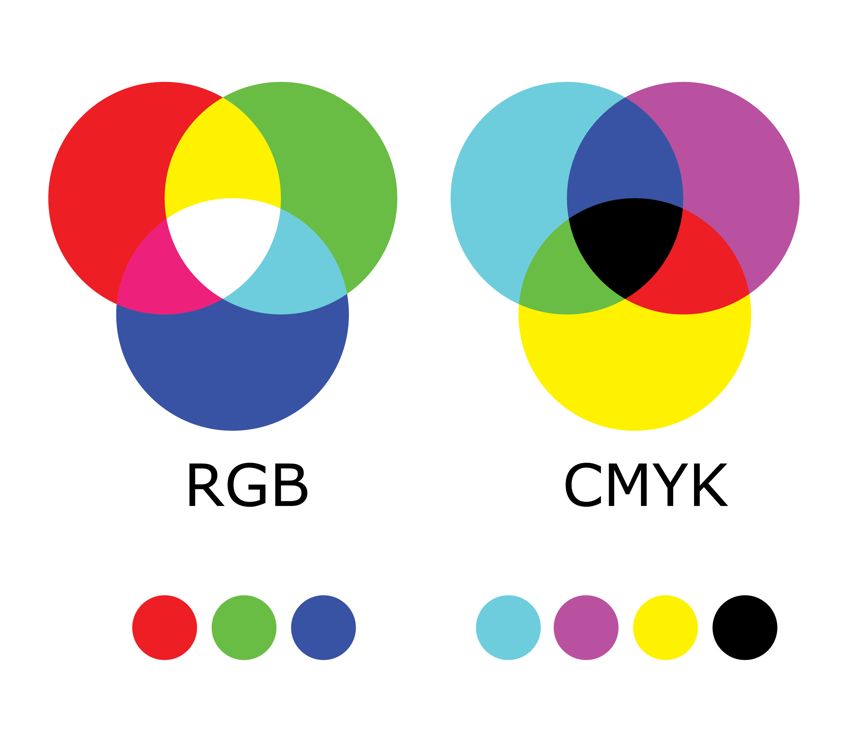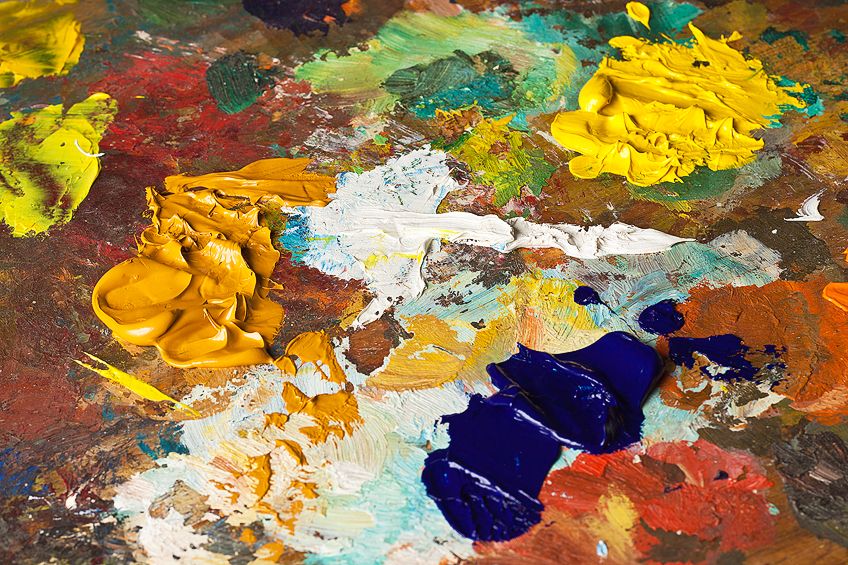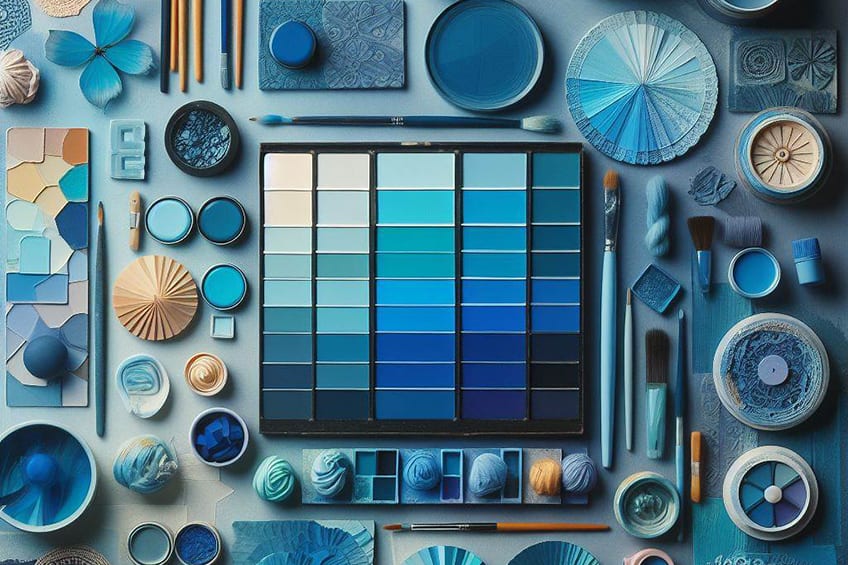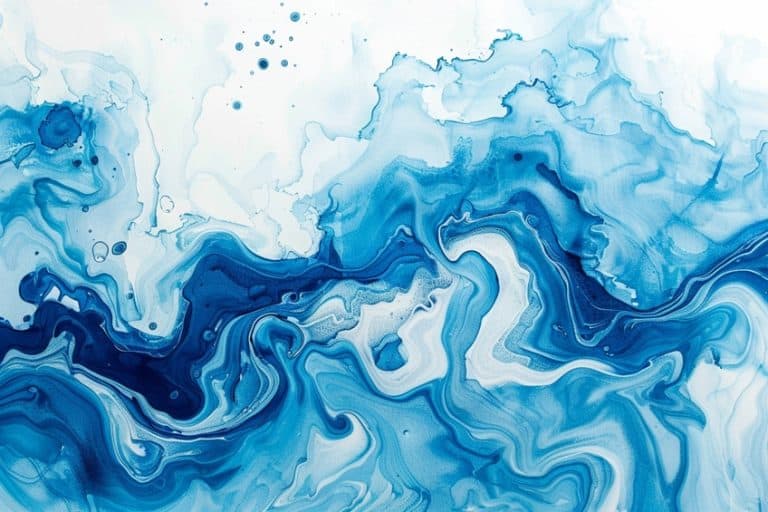What Colors Make Blue? – How to Make Blue Paint Recipes
A recent global survey found that blue was the most popular color in ten countries, with 33% of the British population claiming blue as their favorite color. Not only is this shade incredibly popular, but it is also an essential element to any painting. Blue is all around us, from waterfalls to lakes. Whether you are an artist, graphic designer, or simply a color enthusiast, we’ve created this to-the-point guide to guide you as quickly as possible through all the knowledge and offer you 25 mixing recipes to make the most popular pink shades yourself.
Is it Possible to Mix Blue?
Blue is a primary color in the RGB color model used in digital screens and the RYB color model used in traditional painting and art education, meaning it cannot be created through the mixture of other colors in these contexts.

In the CMYK color model used for printing, blue can be made by mixing cyan and magenta inks. The exact shade of blue can be adjusted by varying the amount of cyan or magenta used.
Recipes on How to Make Blue Shades
We present a table that outlines the mixing recipes for making some of the most popular shades of blue.
| Color Name | Mixing Recipe |
|---|---|
| Dodger Blue | Primary Blue with a touch of White |
| Cornflower Blue | Primary Blue, hint of Ultramarine and White |
| Deep Sky Blue | Primary Blue, hint of Phthalo Green and White |
| Steel Blue | Primary Blue, small amount of Black and White |
| Cadet Blue | Cobalt Blue, touch of Emerald Green and White |
| Powder Blue | Primary Blue, hint of Cerulean and lots of White |
| Light Blue | Primary Blue with a lot of White |
| Sky Blue | Primary Blue, hint of Cerulean and White |
| Light Sky Blue | Sky Blue with more White |
| Royal Blue | Ultramarine Blue, touch of Phthalo Blue and White |
| Primary Blue | Pure Blue |
| Navy Blue | Primary Blue with a hint of Black |
| Midnight Blue | Primary Blue, significant amount of Black |
| Dark Blue | Primary Blue with Black |
| Medium Blue | Primary Blue with a hint of White |
| Dark Slate Blue | Slate Blue with more Primary Blue |
| Slate Blue | Primary Blue, hint of Ultramarine and a touch of Red |
| Medium Slate Blue | Slate Blue with more White |
Two Broad Ways of Conceptualizing Color Theory
For many of us, there is only one model of color theory that we use to mix different colors. This basic color theory includes the three primary shades, three secondary hues, and a range of tertiary colors. If we are to use this foundational color theory to make blue, we are only going to be able to create different shades of blue. The reason behind this is that blue is one of the primary hues, and according to this color theory, cannot be made by combining other shades.

There is another way to conceptualize color. The Cyan, Magenta, Yellow, and Black (CMYK) model of color is based on the system used by printers, and if you use this model of color theory, it is possible to make blue by combining different percentages of these four foundational shades.
We will begin by considering how to make blue with the most well-known foundational color theory, and then go on to explore what colors make blue with the CMYK model.
How to Make Blue Shades with Basic Color Theory
In traditional color theory, understanding color bias is crucial when mixing shades of blue:
- Primary Colors: Blue, red, and yellow are the primary colors. Mixing two primaries creates a secondary color, but mixing all three can result in a muddy brown.
- Color Temperature: Refers to the warmth or coolness of a color. Red is warm, blue is cool.
- Color Bias: Indicates whether a color leans towards the warm red or the cool blue side of the color wheel. Light green, having blue in it, is cooler, while vibrant orange, with red, is warmer.
- Warm and Cool Blues: The temperature of blue hues is determined by their tendency towards purple (warmer due to red) or green (cooler due to yellow).

What Colors Make Blue Cool?
To create cooler blue hues, add a splash of green. The shade of green determines the coolness of the blue:
- Veronese Green: A bright, cool green that leans towards light blue, perfect for cooling down blues. Mix with ultramarine blue for a darker cool blue, or with cobalt blue for a lighter, brighter cool blue.
- Cadmium Green: Warmer due to a hint of red, creating a slightly muted cool blue when mixed with ultramarine blue. Combine with cobalt blue for a lighter and brighter blue shade.

What Colors Make Blue Warm?
To warm up blue shades, you can use:
- Alizarin Crimson: A warm, slightly purple red that contains a bit of blue. Mix with ultramarine blue for a dark, purple-blue shade, or with cobalt blue for a vibrant, warm blue.
- Burnt Sienna: A darker, warmer red that creates a darker warm blue when mixed with ultramarine blue, resulting in a cooler tone than when using alizarin crimson.

What Colors Make Light Blue?
To make light blue shades, the most common method is to add white to blue paint. Ultramarine blue mixed with white creates a vibrant cornflower blue with warm undertones, while cobalt blue with white yields a brighter light blue. Alternatively, adding a small amount of yellow or light green can lighten blue while also giving it a cooler tone.
What Colors Make Dark Blue?
To create dark blue shades, you can use:
- Dioxazine Purple: Adds richness to ultramarine blue, resulting in a rich dark blue. When added to cobalt blue, it creates a slightly muted dark blue due to the red pigments in the purple.
- Burnt Umber: Mutes and darkens blue shades, producing an almost brown dark blue, especially effective for very dark blue tones.
- Phthalo Green and Alizarin Crimson Combination: This mix emulates the effects of burnt umber, providing similar darkening and muting results.

What Colors Make Blue Muted?
To create muted shades of blue for realistic depth and dimension in paintings, you can add a complement of blue, which is orange, to tone down the vibrancy. The specific orange used will vary depending on the blue shade:
- Cadmium Orange: Ideal for muting blue shades, pairing with ultramarine blue for a warm, dull, dark blue, and with cobalt blue to reduce vibrancy.
- Burnt Umber: A darker orange option that darkens and mutes blue tones effectively.

How to Make Blue Shades with the CMYK Color Model
The CMYK model is the method that printers use to create color by combining different percentages of magenta, yellow, cyan, and black.
Making blue with this model is incredibly easy! You can combine cyan and another shade to make blue. So, what colors make cyan turn into blue? The answer is magenta. You can use a combination of magenta and cyan to make a range of blue hues. Your final blue shade will depend on the ratio of these two colors. This is the answer to the question of what two colors make blue!

In 2005, Charlene completed her Wellness Diplomas in Therapeutic Aromatherapy and Reflexology from the International School of Reflexology and Meridian Therapy. She worked for a company offering corporate wellness programs for a couple of years, before opening up her own therapy practice. It was in 2015 that a friend, who was a digital marketer, asked her to join her company as a content creator, and this is where she found her excitement for writing.
Since joining the content writing world, she has gained a lot of experience over the years writing on a diverse selection of topics, from beauty, health, wellness, travel, and more. Due to various circumstances, she had to close her therapy practice and is now a full-time freelance writer. Being a creative person, she could not pass up the opportunity to contribute to the Art in Context team, where is was in her element, writing about a variety of art and craft topics. Contributing articles for over three years now, her knowledge in this area has grown, and she has gotten to explore her creativity and improve her research and writing skills.
Charlene Lewis has been working for artincontext.org since the relaunch in 2020. She is an experienced writer and mainly focuses on the topics of color theory, painting and drawing.
Learn more about Charlene Lewis and the Art in Context Team.
Cite this Article
Charlene, Lewis, “What Colors Make Blue? – How to Make Blue Paint Recipes.” Art in Context. June 21, 2021. URL: https://artincontext.org/what-colors-make-blue/
Lewis, C. (2021, 21 June). What Colors Make Blue? – How to Make Blue Paint Recipes. Art in Context. https://artincontext.org/what-colors-make-blue/
Lewis, Charlene. “What Colors Make Blue? – How to Make Blue Paint Recipes.” Art in Context, June 21, 2021. https://artincontext.org/what-colors-make-blue/.









